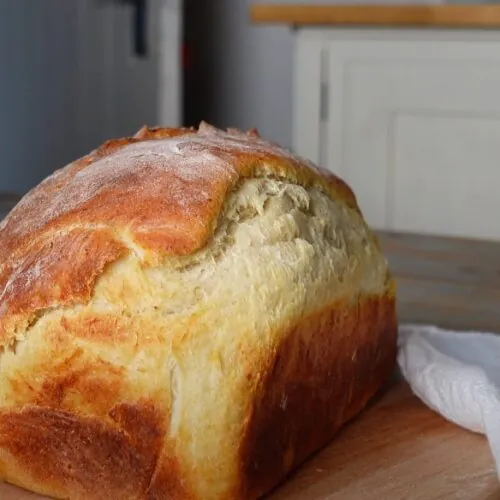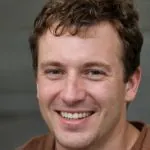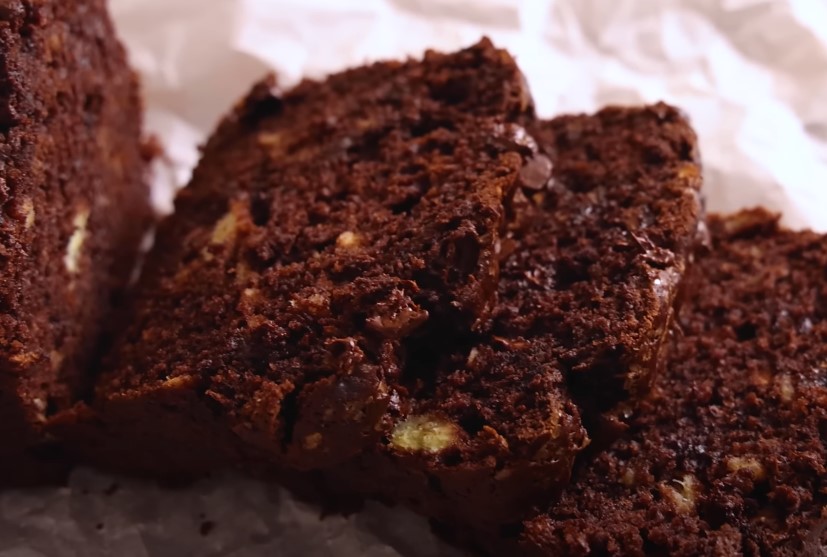Cottage cheese bread brings a gentle tang and moist crumb to any kitchen table. It’s one of those culinary gems that pair beautifully with savory soups, hearty sandwiches, or even a sweet spread of jam.
Baking it at home brings a comforting aroma that lifts the spirit and warms the heart.
Today, I will share some guidance on making a cottage cheese loaf that turns out tender, flavorful, and downright delightful every single time. Let’s get right into it.

Table of Contents
ToggleCottage Cheese Bread: A Delightful Tangy Loaf
Equipment
- 1 Large mixing bowl
- Measuring cups and spoons
- 1 Whisk or fork
- 1 Stand mixer with dough hook (optional)
- 1 Loaf pan (9x5 inches) or baking sheet
- 1 Kitchen thermometer (optional)
- 1 Damp cloth or plastic wrap
- 1 Wire cooling rack
Ingredients
- 1 cup (240g) cottage cheese (whole milk or low-fat)
- 2 ¼ tsp teaspoons (1 packet) active dry yeast
- ¼ cup (60ml) warm water (110°F/45°C)
- 1 tbsp sugar or honey
- 2 eggs room temperature
- 2 tbsp melted butter or oil
- 3 cups (375g) bread flour or all-purpose flour, plus extra for dusting
- 1 tsp salt
- 1 tsp dried dill or chives (for savory variation) (optional)
Instructions
- Proof the Yeast: Dissolve the yeast in warm water with sugar or honey. Let sit for 5-10 minutes until foamy. If it doesn’t foam, the yeast may be inactive.
- Mix Wet Ingredients: In a large bowl, whisk together the cottage cheese, eggs, and melted butter or oil until smooth.
- Combine Dry Ingredients: In a separate bowl, mix flour, salt, and any optional herbs or seasonings. Gradually add the dry mixture to the wet ingredients, stirring until a sticky dough forms.
- Knead the Dough: Turn the dough onto a floured surface. Knead for 8-10 minutes (or use a stand mixer for 5-7 minutes) until smooth and elastic. Add small amounts of flour if the dough is too sticky.
- First Rise: Place the dough in a greased bowl and cover with a damp cloth or plastic wrap. Let it rise in a warm spot for 60-90 minutes, or until it doubles in size.
- Shape the Dough: Punch down the risen dough to release air. Shape it into a loaf and place it in a greased loaf pan or on a baking sheet.
- Second Rise: Cover and let the shaped dough rise again for 30-45 minutes, until puffy and nearly doubled in size.
- Bake: Preheat the oven to 350°F (175°C). Bake the loaf for 35-40 minutes, until golden brown. An internal temperature of 190°F (88°C) or a hollow sound when tapped signals doneness.
- Cool: Remove the bread from the pan and cool on a wire rack. Wait until fully cooled before slicing.
Notes
Cooking Tips
- Room-Temperature Ingredients: Bring eggs and cottage cheese to room temperature for smoother dough.
- Adjusting Dough Texture: Aim for a slightly tacky dough; add flour or water gradually if needed.
- Enhance Flavor: Try adding fresh herbs or shredded cheese for savory variations, or a touch of honey and dried fruit for sweetness.
- Proofing Tip: On cold days, let the dough rise in an oven with just the light on.
Tips That Help Every Loaf Shine
- Ingredient Temperatures: Room-temperature cottage cheese and eggs allow for smoother mixing and better yeast activity.
- Dough Texture: Aim for a slightly sticky dough that still holds form. Adjust by adding small amounts of flour or liquid until it feels right.
- Flavor Experiments: Try adding dill, chives, or a bit of shredded cheese for a savory variation. If a sweeter loaf feels appealing, include dried fruit or a drizzle of honey.
- Creating a Warm Rising Environment: On chilly days, let the dough rise in an oven with just the light on, or near a bowl of warm water. Good rising conditions lead to a fluffier loaf.
- Storage: Once cooled, keep the bread in an airtight container at room temperature for up to three days. To preserve it longer, freeze slices and toast them as needed.
Nutritional Benefits
Cottage cheese naturally contributes protein and calcium, making the loaf a bit more nutrient-dense than a standard white bread. Whole milk varieties add a bit more richness and calories, while low-fat options keep it lighter.
That versatility appeals to those monitoring their fat intake or seeking a higher-protein bread. The same is with higher-protein deserts.
The final product offers a balanced profile—carbohydrates from the flour, protein from cottage cheese and eggs, and a touch of healthy fats from butter, clarified butter, or oil. It’s a nice alternative for anyone who wants a delicious bread without sacrificing nutrition.
Resolving Common Issues

Dense Loaf
- Possible Causes: Inadequate kneading, too little rising time, or inactive yeast.
- Solutions: Knead until dough feels smooth. Allow enough time for the dough to fully double. Always use fresh, active yeast.
Overly Sticky Dough
- Possible Causes: Too much moisture or a high-humidity environment.
- Solutions: Add flour one tablespoon at a time while kneading until dough feels manageable. Avoid dumping in large amounts of flour, which can lead to dry, tough bread.
Flat or Spread-Out Loaf
- Possible Causes: Overproofed dough, resulting in too much gas release, causing the loaf to collapse.
- Solutions: Keep a close eye on the second rise. Shape the dough tightly to provide structure. Avoid letting it rise too long before baking.
Dry or Crumbly Texture
- Possible Causes: Overbaking or an imbalance in moisture and flour.
- Solutions: Check doneness with a thermometer. Stick to the recipe’s measurements and make only minor adjustments if needed.
Mild or Lacking Flavor
- Possible Causes: Cottage cheese offers subtle flavor. Some palates crave a stronger kick.
- Solutions: Increase salt or experiment with herbs, garlic powder, or a sprinkle of cheese on top. Brushing melted butter on the finished loaf boosts flavor and visual appeal.
Why Cottage Cheese Bread Outshines Ordinary Loaves
Cottage cheese bread isn’t just a novelty. It shines by bringing a distinctive texture and taste that stand apart from standard bread recipes.
The moist, tender crumb pleases the senses, while its adaptability encourages frequent experimentation.
It can lean savory or sweet. It can be part of a balanced breakfast or a comforting dinner side. Few breads move so effortlessly between all sorts of meals, especially meals with higher protein.
Personalizing the Recipe
- Sweet Morning Bread: Add raisins, dried cranberries, a pinch of cinnamon, or a touch of vanilla.
- Savory Gourmet Loaf: Incorporate shredded cheddar, pepper jack, or parmesan. Add some rosemary or thyme for a more robust flavor.
- Gluten-Free Variation: Use a gluten-free flour blend and slightly increase liquids if necessary, as gluten-free flours often need more moisture.
- Seeded Topping: Sprinkle sesame seeds, sunflower seeds, or flaxseeds on top before baking to add crunch and extra nutrients.
Suggested Baking Timeline
- Day Before: Gather and measure ingredients. Let cottage cheese and eggs stand at room temperature.
- Morning: Mix and knead dough. Let it rise for about 1 to 1.5 hours.
- Afternoon: Shape dough, allow a second rise (30-45 minutes), then bake.
- Later in the Day: Cool the bread fully before slicing for the best texture.
Serving and Storing
- Serving Tips: Toasting brings out flavors and textures. Spread with butter, jam, cream cheese, or drizzle with honey for a sweet touch. At dinner, serve next to soups or salads.
- Storage: Wrap the cooled loaf in plastic wrap or foil, and keep at room temperature for up to three days. For longer storage, freeze sliced portions and toast as desired.
- Reheating: Warm slices in a 350°F (175°C) oven for about 5-7 minutes, or pop them in a toaster. The gentle warmth makes the bread taste just-baked again.
Final Words
Cottage cheese bread proves that homemade loaves don’t need to be complicated or intimidating. It’s a cozy, nourishing baked good that fits easily into daily life. The step-by-step guidance above can turn each baking attempt into a success.
From first-time bakers to seasoned pros, anyone can appreciate the subtle tang, tender crumb, and endless customization options. Give it a whirl, get creative, and let cottage cheese bread become a trusty companion in the kitchen.
Its comforting aroma, versatile flavor, and satisfying texture might just earn it a permanent spot in your baking rotation. Enjoy every slice!
Related Posts:
- The Only Cottage Cheese Pancakes Recipe You’ll Ever Need
- How to Cook with Ghee – Flavor Pairings, Tips & Storage
- Healthy Cottage Cheese Waffles with Just 3 Ingredients
- Perfect Swedish Meatballs Recipe - Creamy, Juicy &…
- Quick & Easy 3-Ingredient Banana Oat Bread Recipe
- Homemade Bread for Beginners: No-Knead & Foolproof








